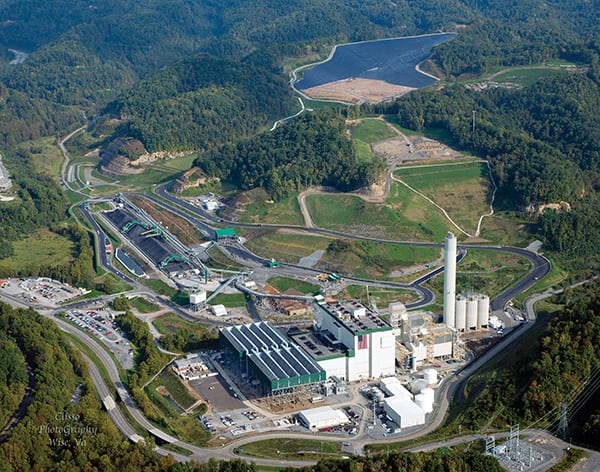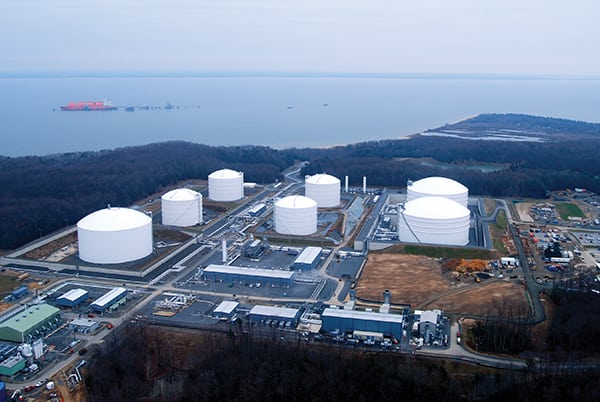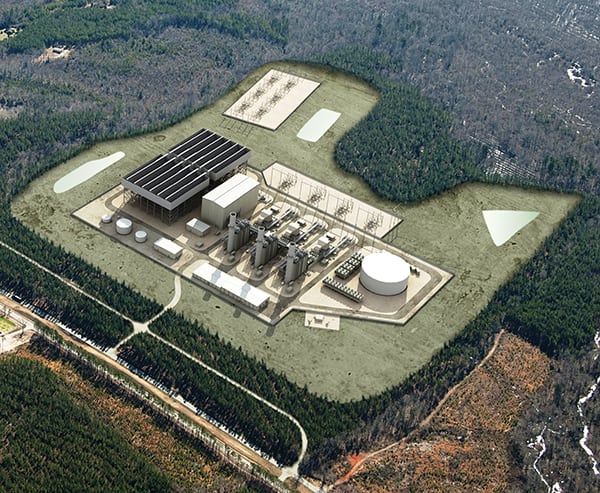Dominion Resources Broadens Its Reach
Dominion Resources, a large electric and gas utility holding company serving mostly Virginia and North Carolina, has big ambitions to spread its wings nationally and internationally in gas, while carefully hedging its electricity business. The company’s strategy is eclectic.
“Eclectic.” Miriam-Webster’s Collegiate Dictionary, 11th Edition, defines the word as “1: selecting what appears to be best in various doctrines, methods, or styles. 2: Composed of elements drawn from various sources.”
That definition applies well to the business strategy of Dominion Resources, a large electric and gas company based in Richmond, Va., and a player in nuclear, coal, natural gas, big hydro, and renewables. The company has long hedged its bets on what the future of power generation and profitable energy businesses will be.
“We certainly fit that definition,” Dominion chairman, president, and CEO Thomas F. Farrell II told POWER in a March interview (Figure 1). About the only other U.S. utility that fits Dominion’s model, he said, is California’s Sempra Energy, the parent company of San Diego Gas & Electric, which also has substantial U.S. and international natural gas operations. For Dominion, Farrell said, the company’s current configuration is the result of “a very deliberate plan we started executing eight years ago,” including selling off 60% of its electric merchant plant investments.
 |
|
1. Dominion Resources chairman, president, and CEO Tom Farrell. Courtesy: Dominion Resources |
Dominion’s latest gambit is its February bid for Questar Corp., which would see the Virginia-based firm acquire Salt Lake City’s Questar for $4.4 billion in cash and assumption of debt. Questar is a gas pipeline, storage, and local distribution company (LDC) serving about a million homes in Utah, Wyoming, and Idaho (see sidebar, “Wave of Electric-Gas Combinations”).
|
Wave of Electric-Gas Combinations Dominion’s planned $4.4 billion purchase of Questar Corp. is riding a wave of multi-billion-dollar deals where electric-centric companies are purchasing gas assets. Questar (not the telescope company) will enlarge Dominion’s natural gas footprint, turning the Richmond, Va., company from a regional giant into a national presence. An analysis of the Questar deal by Jim Collins in Forbes magazine says it contains a “hidden gem” for Dominion: Questar’s natural gas exploration and production subsidiary, Wexpro. This is Questar’s least-known, but most profitable operation, producing natural gas in Wyoming, Colorado, and Utah for sale to Questar’s retail gas customers. Collins explains, “The key is that Wexpro operates as an internally-owned utility and thus sells its gas to parent Questar on a cost-of-service basis, not at market rates. Those costs-of-service reflect years of drilling costs (net of depreciation) and are wildly higher than prevailing market rates.” Meanwhile, last August, Southern Company unveiled a $12 billion deal to acquire AGL Resources. Both companies are headquartered in Atlanta. Southern is primarily a large, regulated electric company, while AGL is one of the nation’s largest gas distribution utilities. The combined company, according to a joint press release, will be “the second-largest utility company in the U.S. by customer base.” It will feature 11 regulated electric and gas distribution companies with about 9 million customers, nearly 200,000 miles of electric transmission and distribution lines, more than 80,000 miles of gas pipelines, and about 46,000 MW of electric generating capacity. In October, Duke Energy announced it would buy Piedmont Natural Gas for $4.9 billion in cash. Both are based in Charlotte, N.C. Duke CEO Lynn Good said, “This combination provides us with a growing natural gas platform, benefitting our customers, communities and investors.” Duke Energy bills itself as “the largest electric power holding company in the United States,” with 7.3 million electric customers in six states in the Southeast and Midwest. Piedmont is primarily a gas distribution utility, serving about 1 million customers in parts of North Carolina, South Carolina, and Tennessee, including wholesale municipal customers. Duke and Piedmont are already partners in the $5 billion Atlantic Coast Pipeline (Dominion and AGL are partners as well), the first major gas pipeline to serve eastern North Carolina. At the same time as the Questar deal, Canada’s Algonquin Power & Utilities Corp. announced a deal to buy the Empire District Electric Co. of Joplin, Mo., for $2.4 billion. Empire, which has about 218,000 retail electric, gas, and water customers in Missouri, Kansas, Oklahoma, and Arkansas, will become a wholly owned subsidiary of Algonquin’s Liberty Utilities. Algonquin, based in Oakville, Ontario, describes itself as a “diversified generation, transmission and distribution utility,” with about 560,000 electric, gas and water customers in the U.S., a portfolio of wind, solar, hydro, and gas generation totaling about 1,100 MW, and regulated electric transmission and gas pipeline systems in the U.S. and Canada. Dominion CEO Tom Farrell, noting the recent flow of electric-gas combinations, observed drily, “Yes, we did that 16 years ago. Others just started last year.” That’s a reference to the 2000 acquisition of CNG for $9 billion. |
The deal reflects Dominion’s strategic decision to reach beyond its traditional markets in the Mid-Atlantic region, adding “geographic diversity,” in the company’s words, to its business profile. Dominion, already strong in natural gas in its traditional territory, says it is expanding its gas interests as the Obama administration’s Clean Power Plan makes low-cost gas more attractive. In the press release announcing the Questar acquisition, Dominion said it “expects the value of the Questar pipeline system to rise over time as Utah and other Western states seek to comply with the requirements of the U.S. Environmental Protection Agency’s (EPA’s) Clean Power Plan and meet state-mandated renewable standards, with increasing reliance on low-carbon, gas-fired electric generation.”
Farrell said the Questar buy makes a lot of sense. Utah, he said, “is one of the fastest-growing states, with a fair-minded, balanced regulatory situation.” He added that Questar’s pipeline assets are integrated into the West’s system, similar to the way Dominion’s system integrates into the Middle Atlantic gas grid.
The Dominion Resources operating companies, according to its web site, feature “24,300 megawatts of generation, 12,200 miles of natural gas transmission, gathering and storage pipeline, and 6,500 miles of electric transmission lines. Dominion operates one of the nation’s largest natural gas storage systems with 933 billion cubic feet of storage capacity and serves utility and retail energy customers in 14 states.” Dominion’s eclecticism is shown in a simple recitation of its existing businesses, not counting Questar:
■ Dominion Virginia Power, an electric distribution utility in Virginia
■ Dominion North Carolina Power, an electric distributor in the Tar Heel State
■ Electric Transmission, an electric transmission company in Virginia and North Carolina
■ Dominion East Ohio, a gas LDC in the Buckeye State
■ Dominion Hope, a West Virginia LDC
■ Dominion Transmission, operating gas pipelines and gas storage
■ Dominion Cove Point LNG, a liquefied natural gas (LNG) import facility in Maryland (currently converting to LNG export)
■ Dominion Gathering-Producer Services, overseeing gas delivery points into the Dominion pipeline system
■ Dominion Midstream Partners, a master-limited partnership that owns, operates, and develops natural gas infrastructure, including a major investment in Cove Point
■ Dominion Clearing House, trading in wholesale gas, electricity, coal, oil, and emissions contracts
■ Dominion Energy Solutions, a retail marketing arm for natural gas services in deregulated markets
■ Dominion Generation, managing the company’s electric generating stations
Generation Diversity
On the generation side of the company, the diversity and eclecticism are also evident. On the utility side, Dominion has 5,661 MW of coal-fired capacity (declining for the past several years), 5,062 MW of natural gas generation (which has been growing), 3,568 MW of nuclear power (stable), 3,315 MW of hydro (also unchanged over many years), 881 MW of oil-fired capacity, and 236 MW of biomass generation (all wood waste, including conversion of small, older coal-fired plants as well as a portion of the output from the coal-biomass Virginia City Hybrid Energy Center, a 2012 POWER Top Plant, Figure 2).
 |
|
2. Hybrid power. Dominion’s 585-MW Virginia City Hybrid Energy Center in Wise County, Va., burns coal and up to 20% biomass. The plant came online in 2012. Courtesy: Dominion Resources |
Dominion also has over 4,460 MW of merchant power generation (including 2,080 MW of nuclear at the Millstone plant in Connecticut), 2,145 MW of gas capacity (with 15 MW of gas fuel cell generation), 306 MW of solar photovoltaic (PV), and 433 MW of wind.
The company has been gingerly testing the wind and solar markets. According to Farrell, Dominion is committed to adding 400 MW of solar in Virginia by 2020. In March, Dominion Virginia Power, the state of Virginia, and Microsoft announced a deal for a 20-MW PV array on utility land in Fauquier County. Virginia Power will build and operate the plant, while Microsoft will buy and retire renewable energy credits. Virginia will buy the power to supply state agencies.
Dominion was one of the utilities that saw low-cost merchant nuclear plants as a business opportunity a decade ago. The idea was that the company could buy distressed plants from utilities, mostly in the Midwest, then use its multi-unit expertise and economies of scale to run the nukes more cheaply and compete for markets. Unfortunately, that approach did not quite turn out as intended.
In 2005, Dominion bought the 574-MW Kewaunee pressurized water reactor from Wisconsin Public Service and Wisconsin Power & Light for $220 million in cash (reaping some $390 million in the plant’s decommissioning fund as part of the purchase). The deal included a power purchase contract with the Wisconsin utilities that expired in 2014. But the Kewaunee purchase was the only Midwest merchant nuclear acquisition Dominion was able to conclude.
By 2010, new natural gas supplies, the product of fracking, had flooded the market, eroding wholesale power prices. Awash in cheaper electricity, the Wisconsin utilities saw no reason to renew the Kewaunee contract. Dominion knew it couldn’t make money from Kewaunee otherwise and tried to find a buyer. It put the plant on the used-nuke sales lot in 2011. Failing to find someone to take Kewaunee off its hands, Dominion announced in 2012 that it would close the plant by mid-2013.
At the announcement of Kewaunee’s closure, Farrell said, “This decision was based purely on economics. Dominion was not able to move forward with our plan to grow our nuclear fleet in the Midwest to take advantage of economies of scale.” Decommissioning is underway. The two Millstone units in Connecticut, however, “have always been good performers,” Farrell said, primarily because ISO-NE has a capacity market, while MISO, where Kewaunee was located, does not.
Dominion’s Deep Roots
According to CEO Farrell, today’s Dominion Resources is the product of a 2000 acquisition of Consolidated Natural Gas (CNG), a Pittsburgh-based Fortune 250 company (originally part of the Rockefeller’s Standard Oil behemoth), for $9 billion. That’s where Dominion got into the local gas distribution business in a big way. When it’s finished with the expansion and reconfiguration of the Cove Point LNG terminal (Figure 3) on Maryland’s eastern shore of the Chesapeake Bay and the new Atlantic Coal Pipeline, Dominion will have increased the original CNG asset base by a factor of eight. At that point, Dominion’s earnings will be about 50% electricity and 50% gas, according to Farrell.
Looking deep into history’s dark corners, Dominion Resources rather extravagantly claims its roots go back to 1787, far earlier than any other U.S. energy company. Dominion’s website says its claim is based on the action of the Virginia General Assembly at the time, which chartered the Appomattox Trustees, which oversaw The Upper Appomattox Co. That business had a mission to improve navigation on the Appomattox River, as river and canal transport was a key to the economics of the new republic.
Dominion also traces its ancestry through the Rappahannock Co. (1811) and the Roanoke Navigation Co. (1812), both formed to develop canals and improve river navigation in Virginia and eastern North Carolina. The next milestone, according to the company, came in 1859, with the creation of the Richmond Union Passenger Railway Co., one of the nation’s first horse- and mule-drawn streetcar companies.
Then, in 1882, the more conventional history kicks in, with Thomas Edison’s Pearl Street Station and, in 1885, with Nicola Tesla’s introduction of alternating current. In 1888, Edison’s assistant Frank Sprague installed the first successful large electric railway system in Richmond. In 1901, the Virginia Passenger and Power Co. won a franchise to operate electric streetcars and power plants, and in 1909 incorporated to supply electric power and manufactured (coal) gas to retail customers. The company was owned by Frank Jay Gould, son of the legendary 19th century railroad magnate Jay Gould.
In 1925, a Stone & Webster syndicate bought the company from Gould and merged it with Spotsylvania Power Co. of Fredricksburg, Va., forming the entity that would be known for the next 60 years as Virginia Electric and Power Co. (VEPCO), a both admired and reviled monopoly. In 1947, VEPCO became an investor-owned utility, serving some 450,000 electric and gas customers in the state. One of the nation’s earliest state-oriented consumer advocacy groups, the Virginia Citizens Consumer Council, was formed in 1967 largely to oppose VEPCO electric rate hikes. The organization is still alive today and still fighting the utility.
VEPCO became Dominion Resources in 1983, as the utility transformed itself into a holding company, aimed at taking advantage of regulated and unregulated business opportunities. VEPCO became Virginia Power, the holding company’s regulated electric subsidiary. Dominion then began operating North Carolina Power. The company grew during the 1980s and 1990s, becoming a Fortune 250 company.
Dominion’s Future
Looking ahead, natural gas will be the major focus of Dominion’s attention, particularly as the basis of its continuing transition away from coal in electrical generation. “If you look at the integrated resource plan filed last year,” said Farrell, “there is a lot of gas in the future for our company.” Dominion is building a 1,358-MW gas-fired combined cycle plant in Brunswick County, Va., scheduled for completion this summer (Figure 4).
The billion-dollar plant, the company said in a 2012 press release, “[will] replace the electricity generated by coal units at two eastern Virginia stations that are planned to be retired and [will] help meet customers’ growing demand for electricity.” Farrell said, “The Brunswick County site offers us an ideal location to generate electricity to serve Southside Virginia and Hampton Roads reliably and will help us close the gap of 4,000 megawatts in additional peak demand that our customers are expected to need within the next decade.”
Last year, Dominion announced plans for an even larger 1,600-MW gas plant in Greensville County, Va., with a price tag north of $1 billion. That plant would consist of three gas turbines and a steam-turbine generator set. David Christian, head of Dominion Generation, said, “We are proposing to construct the largest and most efficient natural-gas fueled power station in Virginia to bring our customers reliable, low-cost energy.”
With the plant planned to be in operation in 2019, Dominion has applied to local governments and the state regulatory body, the State Corporation Commission, for development on a site close to electric transmission and gas supply pipelines, water, railroads, and major highways. The company said it expected to hear from the regulators on the plant as this article was in production.
Dominion is also facing an uncertain future when it comes to the Obama administration’s Clean Power Plan, now in limbo in federal court but likely to come to a conclusion in 2017 or 2018. If upheld by the Supreme Court, the EPA’s regulatory plan is likely “to increase rates, it’s just a matter of how much,” said Farrell. Virginia is working on developing a state implementation plan for the federal rule. How that will impact Dominion, Farrell told POWER, “depends on which way they go and the choices they make.”
The utility is already facing closure of two coal-fired power plants as a result of the EPA Mercury and Air Toxics Standards. The company got a reprieve from the EPA to keep the plants operating until April 2017. Another challenge has been dealing with new attention directed at coal ash disposal from its shrinking coal fleet (see sidebar, “Dominion and the Politics of Coal Ash”).
|
Dominion and the Politics of Coal Ash Dominion has been getting slammed in social media and by some local environmental groups over its plan to drain and close 11 coal ash ponds at four coal-fired power plants, following up on rules the EPA enacted last year. Virginia’s water quality agency approved the plans in January, setting off protests and a Twitterstorm, charging that the utility will be dumping coal ash directly into the James River. Except that’s not what the utility proposed and regulators approved. An agreement between Virginia Power and the James River Association over the coal ash ponds at the Bremo Power Station, a gas-fired thermal plant converted from coal in 2014, outlines the basics. The utility will remove the water from the ponds, run the water through an “enhanced” wastewater treatment plant, and then into the river. The utility will also test fish in the area. As some observers have noted, the treated water will actually improve water quality in the James. Nonetheless, in late February some 200 protesters gathered in Richmond and marched past the state Department of Environmental Quality offices and Dominion’s corporate headquarters. They carried the usual signs and megaphones and chanted, “Coal ash kills. No dumping, no spills.” That response raises the hackles of CEO Tom Farrell. “There is a lot of misinformation floating around in social media,” he told POWER. “We are over-complying with EPA regulations. EPA says coal ash is not a hazardous waste. The most ludicrous stuff is being said by people who apparently have no conscience or any regard for the truth.” |
Dominion also has ambitions for its nuclear fleet despite an uncertain environment for nuclear power. The company has an application at the U.S. Nuclear Regulatory Commission (NRC) for a combined construction-and-operating license for a third unit at its North Anna plant. The company is partnering with General Electric for an advanced boiling water reactor (all of Dominion’s current nuclear units are pressurized water designs) at the site. An NRC licensing decision is probably 18 months to two years away, at which point Dominion’s management would go to its board of directors for a decision on North Anna.
Dominion is also proposing to apply for a second license extension for its two-unit Surry plant, which would extend its life out to 80 years—a first for any U.S. reactor. Though it hasn’t formally applied yet, it put the NRC on notice last November to expect the application by 2019.
For the future, Farrell said, “We just need to build energy infrastructure in electricity and gas to meet our customers’ needs. That’s what we have been doing and will be doing.” Are there any other acquisitions such as Questar in the works? “Nope,” said Farrell, “no plans.” ■
— Kennedy Maize is a frequent POWER contributor.

